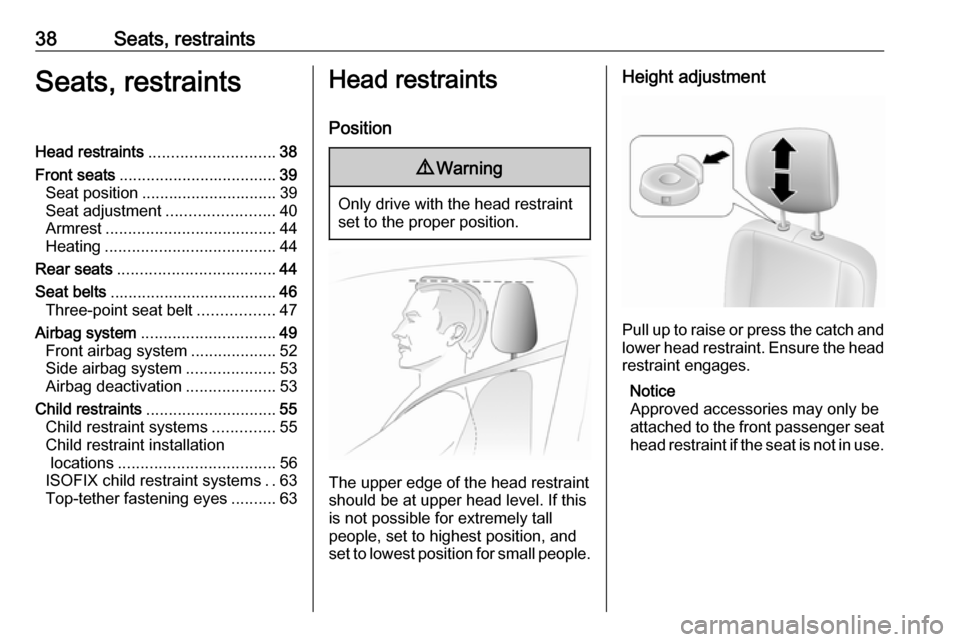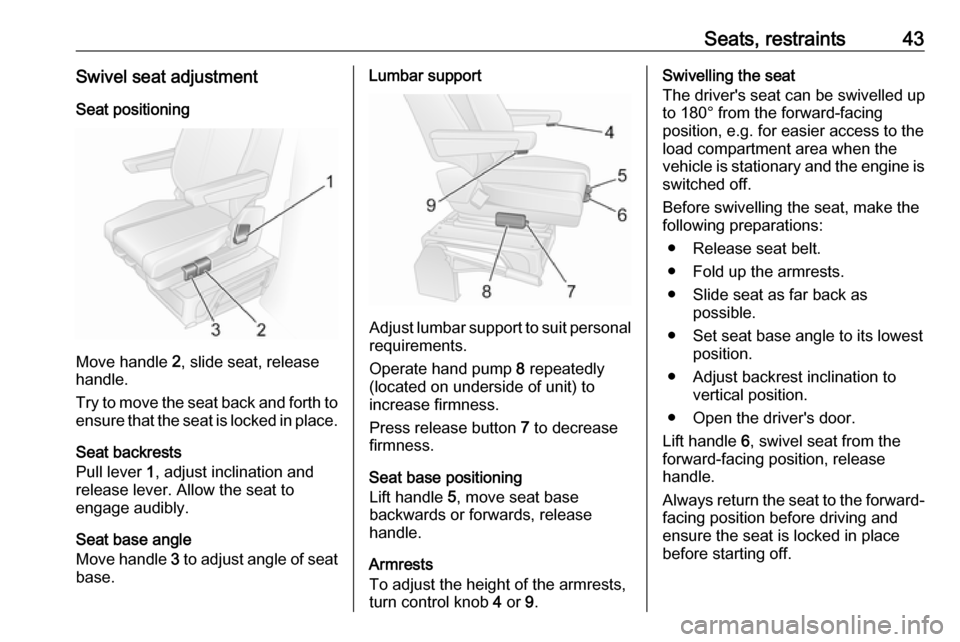Page 9 of 233
In brief7Seat adjustmentSeat positioning
Pull handle, slide seat, release
handle.
Try to move the seat back and forth to ensure that the seat is locked in place.
Seat position 3 39, Seat adjustment
3 40.
9 Danger
Do not sit nearer than 25 cm from
the steering wheel, to permit safe
airbag deployment.
Seat backrests
Pull lever, adjust inclination and
release lever. Allow the seat to
engage audibly.
Seat position 3 39, Seat adjustment
3 40.
Seat height
Lever motion
up:seat higherdown:seat lower
Seat position 3 39, Seat adjustment
3 40.
Page 10 of 233
8In briefHead restraint adjustment
Press release catch, adjust height,
engage.
Head restraints 3 38.
Seat belt
Pull out the seat belt and engage in
belt buckle. The seat belt must not be twisted and must fit close against the
body. The backrest must not be tilted
back too far (maximum approx. 25 °).
To release belt, press red button on
belt buckle.
Seat position 3 39, Seat belts
3 46, Airbag system 3 49.
Mirror adjustment
Interior mirror
To reduce dazzle, adjust the lever on the underside of the mirror housing.
Interior mirror, Wide view mirror
3 34.
Page 40 of 233

38Seats, restraintsSeats, restraintsHead restraints............................ 38
Front seats ................................... 39
Seat position .............................. 39
Seat adjustment ........................40
Armrest ...................................... 44
Heating ...................................... 44
Rear seats ................................... 44
Seat belts ..................................... 46
Three-point seat belt .................47
Airbag system .............................. 49
Front airbag system ...................52
Side airbag system ....................53
Airbag deactivation ....................53
Child restraints ............................. 55
Child restraint systems ..............55
Child restraint installation locations ................................... 56
ISOFIX child restraint systems ..63
Top-tether fastening eyes ..........63Head restraints
Position9 Warning
Only drive with the head restraint
set to the proper position.
The upper edge of the head restraint
should be at upper head level. If this
is not possible for extremely tall
people, set to highest position, and
set to lowest position for small people.
Height adjustment
Pull up to raise or press the catch and
lower head restraint. Ensure the head restraint engages.
Notice
Approved accessories may only be
attached to the front passenger seat head restraint if the seat is not in use.
Page 45 of 233

Seats, restraints43Swivel seat adjustmentSeat positioning
Move handle 2, slide seat, release
handle.
Try to move the seat back and forth to ensure that the seat is locked in place.
Seat backrests
Pull lever 1, adjust inclination and
release lever. Allow the seat to
engage audibly.
Seat base angle
Move handle 3 to adjust angle of seat
base.
Lumbar support
Adjust lumbar support to suit personal requirements.
Operate hand pump 8 repeatedly
(located on underside of unit) to
increase firmness.
Press release button 7 to decrease
firmness.
Seat base positioning
Lift handle 5, move seat base
backwards or forwards, release handle.
Armrests
To adjust the height of the armrests, turn control knob 4 or 9.
Swivelling the seat
The driver's seat can be swivelled up
to 180° from the forward-facing
position, e.g. for easier access to the load compartment area when the
vehicle is stationary and the engine is
switched off.
Before swivelling the seat, make the
following preparations:
● Release seat belt.
● Fold up the armrests.
● Slide seat as far back as possible.
● Set seat base angle to its lowest position.
● Adjust backrest inclination to vertical position.
● Open the driver's door.
Lift handle 6, swivel seat from the
forward-facing position, release
handle.
Always return the seat to the forward- facing position before driving and
ensure the seat is locked in place
before starting off.
Page 50 of 233
48Seats, restraints
Loose or bulky clothing prevents the
belt from fitting snugly. Do not place
objects such as handbags or mobile
phones between the belt and your body.
9 Warning
The belt must not rest against hard
or fragile objects in the pockets of
your clothing.
Seat belt reminder X 3 84.
Height adjustment
1. Pull belt out slightly.
2. Shift the height adjustment upwards or press button to
disengage and push the height
adjustment downwards.
Adjust the height so that the belt lies across the shoulder. It must not lie
across the throat or upper arm.
9 Warning
Do not adjust while driving.
Page 124 of 233

122Driving and operatingfirst gear. On an uphill slope,
turn the front wheels away from
the kerb.
If the vehicle is on a downhill
slope, engage reverse gear.
Turn the front wheels towards
the kerb.
● Close the windows.
● Turn the ignition key to position
0 and remove it. Turn the
steering wheel until the
steering wheel lock is felt to
engage.
Lock the vehicle 3 21 and activate the
anti-theft locking system 3 30 and
anti-theft alarm system 3 31.
Air suspension
Operates automatically when the
vehicle is driven. The air suspension
system constantly adjusts the ride
height according to the vehicle load.
Caution
To ensure safe operation of the air
suspension system, do not exceed the maximum permissible gross
vehicle weight rating. Refer to
identification plate 3 199 or the
vehicle documents.
For further information on the air
suspension system, refer to the
operating instructions supplied.
Master switch
Caution
The air suspension system must
be switched off when the vehicle is being towed, jump‐started, raised
off the ground or transported.
Do not switch off the air
suspension system when driving.
Jump starting 3 188, Towing the
vehicle 3 190.
The master switch is located on the
door pillar.
Switch on to enable operation and
adjustment of the air suspension
system.
Page 125 of 233

Driving and operating123Remote control
When increased ground clearance orimproved vehicle access is required,the suspension can be raised or
lowered using the remote control.
Caution
Ensure there is adequate
clearance and that there are no
obstructions when adjusting the
suspension height.
The remote control unit is magnetic
and may be fixed to any metal part of the vehicle or stored in its holder.
With the engine running, press theappropriate button for 2 seconds to
adjust the suspension height.
Indicator light will flash intermittently
while height adjustment is in progress
and illuminates when complete.
If the ignition is switched on with
engine not running, the suspension
height can only be lowered.
Notice
Handle with care, protect from
moisture and high temperatures and
avoid unnecessary operation.
Pre-programmed settings
Adjusts the suspension height to one
of three pre-programmed positions.l:lowered positionk:normal positionj:raised positionCaution
If an obstacle is detected while
raising or lowering, the
suspension height is returned to the normal position after a delay.
This does not guarantee damage-
free operation. Ensuring sufficient
clearance and freedom from
obstacles is the responsibility of the driver.
Manual settings
Manual adjustment can only be
performed when the vehicle is
stationary.
Select by pressing h for 2 seconds,
then R to raise, or S to lower.
To exit, press any of the pre-
programmed buttons.
Notice
Obstacle detection is not available
during manual adjustment.
When a certain low speed is
exceeded or when the ignition is
switched off, height adjustment is deactivated automatically and the
suspension height is returned to the
normal position.
Service mode
When the vehicle is stationary, press
i for 5 seconds to put the vehicle into
service mode. The indicator light will
illuminate.
Page 178 of 233

176Vehicle careWinter tyresWinter tyres improve driving safety at
temperatures below 7 °C and should
therefore be fitted on all wheels.
In accordance with country-specific
regulations, affix the maximum speed sticker in the driver's field of view.
Tyre designations
E.g. 215/65 R 16 C 109 R215:tyre width, mm65:cross-section ratio (tyre height
to tyre width), %R:belt type: RadialRF:type: RunFlat16:wheel diameter, inchesC:cargo or commercial use88:load index e.g. 109 is
equivalent to approx. 1030 kgR:speed code letter
Speed code letter:
Q:up to 100 mphS:up to 112 mphT:up to 118 mphH:up to 130 mphV:up to 150 mphW:up to 168 mphDirectional tyres
Fit directional tyres such that they roll
in the direction of travel. The rolling
direction is indicated by a symbol
(e.g. an arrow) on the sidewall.
Tyre pressure
Check the pressure of cold tyres at
least every 14 days and before any
long journey. Do not forget the spare
wheel. This also applies to vehicles
with tyre pressure monitoring system.
The tyre pressure information label
on the driver's door frame indicates
the original equipment tyres and the
correspondent tyre pressures.
Always inflate tyres to the pressures
shown on the label.
Tyre pressures 3 219.
The tyre pressure data refers to cold
tyres. It applies to summer and winter
tyres.
Always inflate the spare tyre to the
pressure specified for full load.Incorrect tyre pressures will impair
safety, vehicle handling, comfort and
fuel economy and will increase tyre
wear.
Tyre pressures differ depending on
various options. For the correct tyre
pressure value, follow the procedure
below:
1. Identify the engine identifier code.
Engine data 3 201.
2. Identify the respective tyre.
The tyre pressure tables show all possible tyre combinations 3 219.
For the tyres approved for your
vehicle, refer to the EEC Certificate of
Conformity provided with your vehicle or other national registration
documents.
The driver is responsible for correct
adjustment of tyre pressure.9 Warning
If the pressure is too low, this can
result in considerable tyre warm-
up and internal damage, leading to tread separation and even to tyre
blow-out at high speeds.